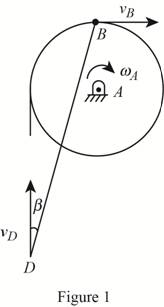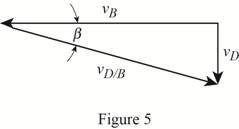
Concept explainers
Knowing that the disk has a constant angular velocity of 15 rad/s clockwise, determine the angular velocity of bar BD and the velocity of collar D when (a) θ = 0, (b) θ = 90°, (c) θ = 180°.

Fig. P15.57 and P15.58
(a)
Find the angular velocity of the bar BD and velocity of the collar D when
Answer to Problem 15.57P
The the angular velocity of the bar BD and velocity of the collar D when
Explanation of Solution
Given information:
The constant angular velocity of the disk is
The distance AB is
Calculation:
Show the disk as shown in Figure 1.

Refer to Figure 1.
Calculate the velocity at B using the relation:
Substitute
Consider that
Show the velocity
Calculate the value of angle
Consider bar BD.
Show the velocity diagram as shown in Figure 2.

Refer to Figure 2.
Show the relation between the velocity
Calculate the velocity of point D with respect to B using the relation:
Substitute
Calculate the angular velocity of bar BD using the relation:
Substitute
Thus, the angular velocity of bar BD is
Calculate the velocity of the collar
Substitute
Thus, the velocity of the collar D is
(b)
Find the angular velocity of the bar BD and velocity of the collar D when
Answer to Problem 15.57P
The angular velocity of the bar BD and velocity of the collar D are
Explanation of Solution
Calculation:
Refer to Part (a).
Show the disk as shown in Figure 3.

Refer Figure 3.
Calculate the velocity at B using the relation:
Substitute
Consider
Show the velocity
Calculate the value of angle
Consider bar BD.
Show the relation between the velocity
Equate the horizontal component of Equation (1).
Equate the vertical component of Equation (1).
Substitute 0 for
Thus, the velocity of the collar is
Calculate the angular velocity of bar BD using the relation:
Substitute
Thus, the angular velocity of bar BD is
(c)
Find the angular velocity of the bar BD and velocity of the collar D when
Answer to Problem 15.57P
The angular velocity of the bar BD and velocity of the collar D when
Explanation of Solution
Given information:
The constant angular velocity of the disk is
The distance AB is
Calculation:
Show the disk as shown in Figure 4.

Refer Figure 4.
Calculate the velocity at B using the relation:
Substitute
Consider
Show the velocity
Calculate the value of angle
Consider bar BD.
Show the velocity diagram as shown in Figure 5.

Refer Figure 5.
Show the relation between the velocity
Calculate the velocity of point D with respect to B using the relation:
Substitute
Calculate the angular velocity of bar BD using the relation:
Substitute
Thus, the angular velocity of bar BD is
Calculate the velocity of the collar
Substitute
Thus, the velocity of the collar D is
Want to see more full solutions like this?
Chapter 15 Solutions
VECTOR MECHANICS FOR ENGINEERS W/CON >B
- My ID#016948724 please solve this problems and show me every step clear to follow pleasearrow_forwardMy ID# 016948724arrow_forwardPlease do not use any AI tools to solve this question. I need a fully manual, step-by-step solution with clear explanations, as if it were done by a human tutor. No AI-generated responses, please.arrow_forward
- Please do not use any AI tools to solve this question. I need a fully manual, step-by-step solution with clear explanations, as if it were done by a human tutor. No AI-generated responses, please.arrow_forwardPlease do not use any AI tools to solve this question. I need a fully manual, step-by-step solution with clear explanations, as if it were done by a human tutor. No AI-generated responses, please.arrow_forward[Q2]: The cost information supplied by the cost accountant is as follows:Sales 20,00 units, $ 10 per unitCalculate the (a/ newsale guantity and (b) new selling price to earn the sameVariable cost $ 6 per unit, Fixed Cost $ 30,000, Profit $ 50,000profit ifi) Variable cost increases by $ 2 per unitil) Fixed cost increase by $ 10,000Ili) Variable cost increase by $ 1 per unit and fixed cost reduces by $ 10,000arrow_forward
- can you please help me perform Visual Inspection and Fractography of the attatched image: Preliminary examination to identify the fracture origin, suspected fatigue striation, and corrosion evidences.arrow_forwardcan you please help[ me conduct Causal Analysis (FTA) on the scenario attatched: FTA diagram which is a fault tree analysis diagram will be used to gain an overview of the entire path of failure from root cause to the top event (i.e., the swing’s detachment) and to identify interactions between misuse, material decay and inspection errors.arrow_forwardhi can you please help me in finding the stress intensity factor using a k-calcluator for the scenario attathced in the images.arrow_forward
 Elements Of ElectromagneticsMechanical EngineeringISBN:9780190698614Author:Sadiku, Matthew N. O.Publisher:Oxford University Press
Elements Of ElectromagneticsMechanical EngineeringISBN:9780190698614Author:Sadiku, Matthew N. O.Publisher:Oxford University Press Mechanics of Materials (10th Edition)Mechanical EngineeringISBN:9780134319650Author:Russell C. HibbelerPublisher:PEARSON
Mechanics of Materials (10th Edition)Mechanical EngineeringISBN:9780134319650Author:Russell C. HibbelerPublisher:PEARSON Thermodynamics: An Engineering ApproachMechanical EngineeringISBN:9781259822674Author:Yunus A. Cengel Dr., Michael A. BolesPublisher:McGraw-Hill Education
Thermodynamics: An Engineering ApproachMechanical EngineeringISBN:9781259822674Author:Yunus A. Cengel Dr., Michael A. BolesPublisher:McGraw-Hill Education Control Systems EngineeringMechanical EngineeringISBN:9781118170519Author:Norman S. NisePublisher:WILEY
Control Systems EngineeringMechanical EngineeringISBN:9781118170519Author:Norman S. NisePublisher:WILEY Mechanics of Materials (MindTap Course List)Mechanical EngineeringISBN:9781337093347Author:Barry J. Goodno, James M. GerePublisher:Cengage Learning
Mechanics of Materials (MindTap Course List)Mechanical EngineeringISBN:9781337093347Author:Barry J. Goodno, James M. GerePublisher:Cengage Learning Engineering Mechanics: StaticsMechanical EngineeringISBN:9781118807330Author:James L. Meriam, L. G. Kraige, J. N. BoltonPublisher:WILEY
Engineering Mechanics: StaticsMechanical EngineeringISBN:9781118807330Author:James L. Meriam, L. G. Kraige, J. N. BoltonPublisher:WILEY





